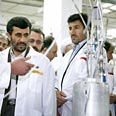
Ahmadinejad at Natanz nuclear plant
Photo: AP

Nuclear plant in Natanz
Photo: AFP
Report: Iran moves nuclear fuel to above-ground plant
New York Times says move baffled IAEA inspectors, as nuclear fuel now exposed to Israel airstrike. 'There’s no technical explanation, so there has to be some other motivation,' US official says. Military officials: This is a tempting moment for the Israelis
About two weeks ago Iran moved nearly its entire stockpile of low-enriched nuclear fuel from the underground plant in Natanz to an above-ground plant, the New York Times (NYT) reported Saturday.
The International Atomic Energy Agency (IAEA) said that on Feb. 14, with inspectors present, the Iranians moved roughly 4,300 pounds of low-enriched uranium out of deep underground storage to the small plant that they have declared they will use to re-enrich the fuel to 20 percent purity. It takes 80- to 90-percent purity to make a nuclear weapon, a "relatively small technological leap" from 20 percent, the report said.
Hezbollah Leader
Hezbollah chief tells Syrian, Iranian presidents 'Zionist regime engaging in psychological warfare'
NYT said the move baffled the IAEA, as an above-ground plant is exposed to aerial attacks. It was as if a bull’s-eye had been painted on it, one official was quoted as saying, while military officials said this is a tempting moment for the Israelis, according to the American newspaper.
The report said the recent visits by National Security Adviser Jim Jones and the Chairman of the Joint Chiefs of Staff Admiral Mike Mullen to Israel were aimed at making sure that Israel does not launch an attack on Iran.
"On the surface, the move made no sense. Iran does not need anywhere near that much fuel for its ostensible purpose: feeding an aging reactor in Tehran that makes medical isotopes. Moreover, the fuel now sits out in the open, where an air attack, or even a carefully staged accident or fire, could destroy it," according to the NYT.
The report said the risk taken by Iran is the subject of "fervent debate" among many who are trying to decipher Tehran's intentions.
"The theories run from the bizarre to the mundane: Under one, Iran is actually taunting the Israelis to strike first. Under another, it is simply escalating the confrontation with the West to win further concessions in negotiations. The simplest explanation, and the one that the Obama administration subscribes to, is that Iran has run short of suitable storage containers for radioactive fuel, so it had to move everything," the NYT said.
"There’s no technical explanation, so there has to be some other motivation,” one senior Obama administration official was quoted by the NYT as saying.
According to the report, the "strangest of speculations" is that Iran's Revolutionary Guards are inviting an attack to unify the country after eight months of anti-government street demonstrations.
A senior European diplomat told the NYT that an Israeli military strike might be the “best thing” for Iran’s leadership, because it would bring Iranians together against a national enemy, but Kenneth Pollack, a scholar at the Brookings Institution told the NYT, "I really doubt they are taunting the Israelis to hit them. It would be humiliating for the Iranian regime." He speculated that Iran would have to retaliate, and “the ensuing confrontation would go in directions no one can really predict.”
The NYT report said the simplest explanation for moving the nuclear fuel to an above-ground plant is that the Iranians had no choice. "The fuel is stored in one big, specialized cask. When someone ordered that the fuel begin being fed into the giant centrifuges for further enrichment, engineers moved it to the only spot available — the exposed plant," the report said.
“You can’t dismiss the possibility that this is a screw-up,” an American intelligence official was quoted by the NYT as saying.















